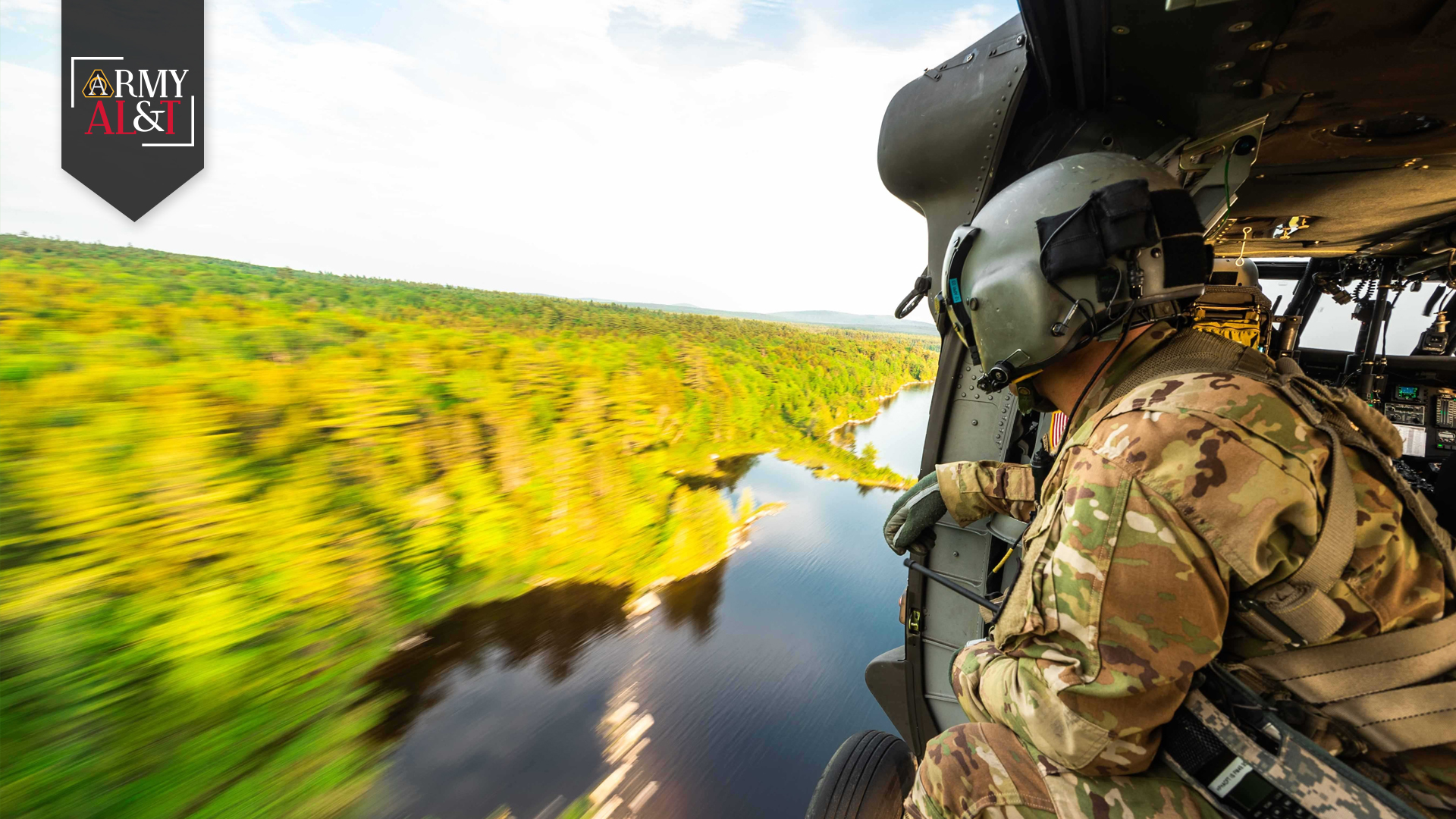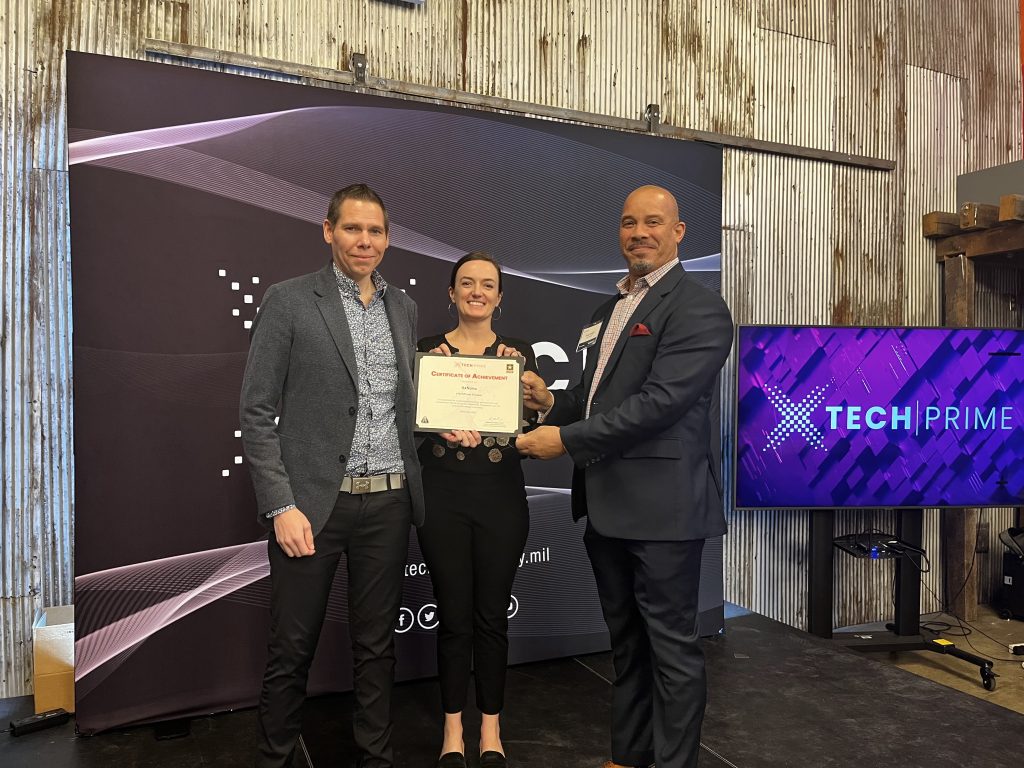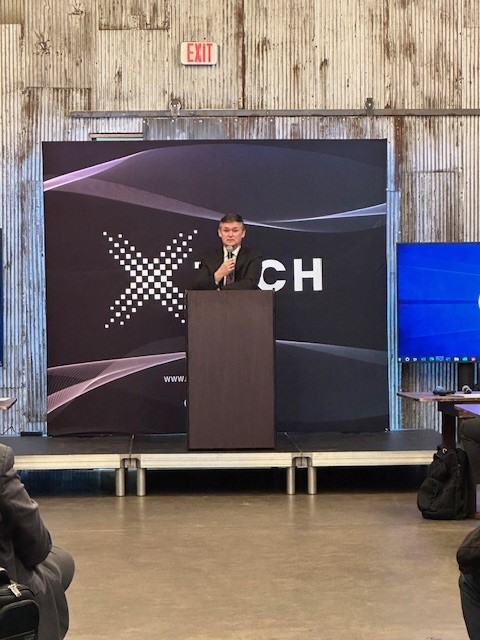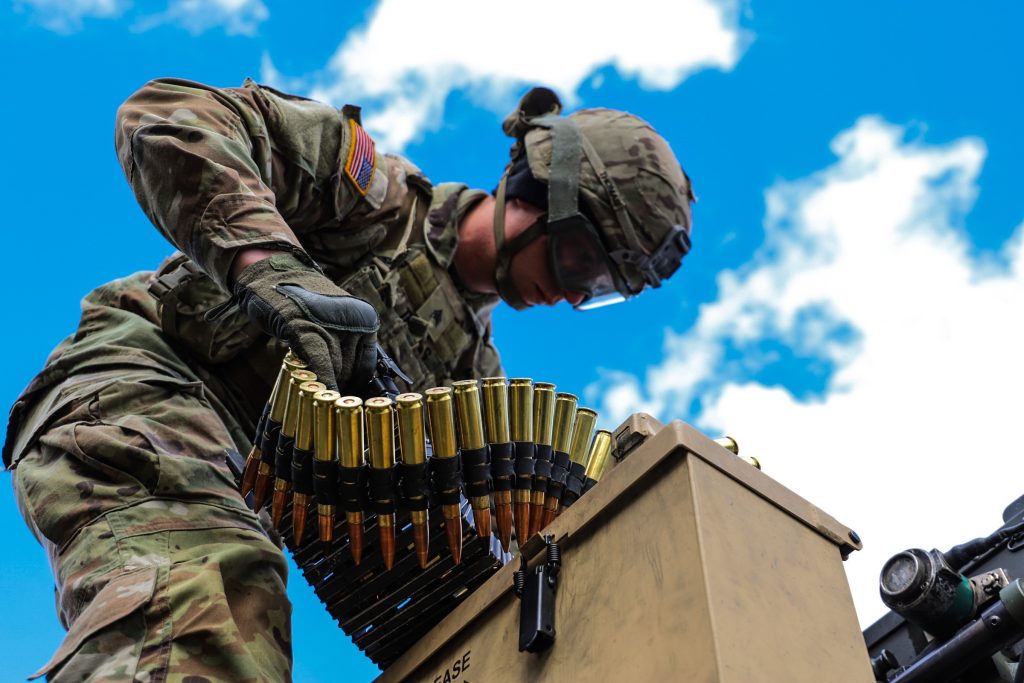
TWO FIGHTS, ONE TECH: Soldiers depend on technology that will provide them with strategic advantages needed to protect our nation and defeat enemies. With the help of ASA(ALT)-led programs, Soldiers can meet these challenges head-on, while also using the latest in clean tech. (Photo by Warrant Officer Patrik Orcutt, U.S. Army National Guard)
SBIR|STTR and xTech programs support the Army’s Climate Strategy by pinpointing ways to mitigate the impacts of climate change while maintaining Soldier readiness.
by Anna Volkwine and Daniel Smoot
With the increasing global threat of climate change—ranging from water scarcity, poor air quality and the spread of disease—the Army aims to do more than simply adapt to these progressing conditions. The Army is pinpointing ways to mitigate the impacts of climate change, while maintaining Soldier readiness and furthering strategic advancements across the defense landscape.
The Army’s weapons of choice to combat climate change are the Army Small Business Innovation Research and Small Business Technology Transfer (SBIR|STTR) and xTech programs. Via the Army SBIR|STTR program, the Assistant Secretary of the Army for Acquisition, Logistics and Technology (ASA(ALT)) offers small and nontraditional businesses opportunities to develop climate and clean technologies that show technical merit, feasibility and commercial potential. Through the xTech program, firms can earn nondilutive cash prizes and a chance to engage with Army subject matter experts. ASA(ALT) combines the strengths of these programs to identify and acquire innovative technologies from nontraditional sources—accelerating the acquisition process and driving “green” objectives to the forefront of the Army’s 2022 Climate Strategy.
ASA(ALT) is collaborating with nontraditional innovators to decrease the Army’s carbon footprint and cultivate a climate-resilient force. Similarly, the congressionally funded ASA(ALT)-sponsored Army SBIR|STTR and xTech programs are competitive, contract- and cash-prize-based initiatives that enable Soldiers and Army experts to provide a pathway for innovators to develop climate and clean tech solutions for the Army.

SOLUTIONS THAT WIN: Matt Willis, Ph.D., director of Army Prize Competitions and the Army Applied SBIR Program, left, congratulates Alexis Carpenter, chief innovation officer, and Doug Speigth, CEO, of AxNano, a climate and clean tech winner from the xTechPrime competition, for their mobile supercritical water oxidation solution. (Photo courtesy of the U.S. Army xTech Program)
CLEAN TECH INITIATIVES
With enterprise-wide efforts to minimize environmental impacts, the Army SBIR|STTR program collaborates with small businesses and Army stakeholders to develop climate and clean technology solutions, including clean energy generation, clean industry technology, clean micro-grid solutions, electric transportation and energy storage. These solutions fall within the Army SBIR program’s climate and clean tech portfolio, which prioritizes maximizing equipment efficiency while minimizing emissions across operations.
Through the Army’s Climate Strategy, the Army seeks to reduce its net greenhouse gas emissions by 50% within the next 10 years. The Army also aims to achieve net-zero greenhouse gas emissions by 2050 by exploring and implementing renewable energy sources and equipment in combat environments. These goals drove the climate and clean tech portfolio’s $76.65 million investment in calendar year 2023, which remained focused on improving the Army’s capabilities, reducing its traditional fuel demand, and cutting greenhouse gas emissions by bringing new technologies—such as the electric vehicle battery total life cycle system for improved electric vehicle battery management, carbon-free Soldier power generator and the sustainable building materials open topic—to Army programs and systems.
“The Army SBIR program’s climate and clean tech portfolio executes its mission of reducing greenhouse gas emissions by buying down risk for larger Army R&D [research and development] and acquisition programs,” said Blaise Zandoli, the Army Applied SBIR program’s portfolio manager for climate and clean tech, and artificial intelligence and machine learning. “This encourages the best and brightest firms within the American small business community to propose their clean technologies for SBIR funding, while enabling Army organizations to benefit from critical, next-generation energy solutions.”
INVESTMENTS IN ACTION
As a part of the Army SBIR|STTR program’s climate and clean technology investments, the program coordinates with Army customers who are addressing the impacts of climate change. These programmatic efforts have helped clean technology use cases flourish across the Army landscape. In addition to the mechanisms offered by the ASA(ALT) Office of Army Prize Competitions and Army Applied SBIR Program, Army organizations are addressing challenges beyond enhancing their capabilities, such as tackling Soldier water shortages in remote locations and reducing hazardous emissions produced by large vehicles.
Inspired by the Army’s Climate Strategy, Army transition partners have continuously sought ways to maintain strategic advantages while deliberately reducing their carbon footprint. These requirements helped influence the U.S. Army Combat Capabilities Development Command Ground Vehicle Systems Center’s (DEVCOM GVSC) small business solicitations for conformable hydrogen storage and hydrogen generators.
“It’s important to note that all our efforts, including those like the conformable hydrogen storage and hydrogen generator solicitations, remain focused on making our warfighters and formations more capable and lethal first,” said Benjamin Paczkowski, a chemical engineer with DEVCOM GVSC. “However, these technologies help address the Army Climate Strategy by enabling the development of zero emissions powertrains—specifically hydrogen fuel cells.”
Through the SBIR contracts awarded under the conformable hydrogen storage solicitation, the Army seeks to develop and mature the next generation of hydrogen storage technology—allowing for increased clean energy storage on electric vehicle platforms. In that same vein, the hydrogen generator solicitation aims to create a contingency system to assist these electric vehicles should they run out of fuel.
As these contracts have progressed, DEVCOM GVSC’s fuel cell team has assisted the Program Executive Office for Combat Support and Combat Service Support Product Manager for Ground Mobility Vehicles with their ongoing research and evaluation of fuel cell-based mobile vehicle chargers for locations without infrastructure.
“Conformable hydrogen storage will allow for future vehicles to have a similar range and capability as current platforms,” Paczkowski said. “The hydrogen generator system will create energy on-demand from a chemical reaction—providing confidence by dramatically increasing operational duration.”

GREEN ANNOUNCEMENT: Honorable Douglas Bush, assistant secretary of the Army for acquisition, logistics and technology, provides opening remarks at the U.S Army xTechPrime finals event in December 2023, where the Army announced three small businesses as the winners under the climate and clean tech topic area. (Photo courtesy of the U.S. Army xTech Program)
xTECH’S GREEN EDGE
ASA(ALT)’s framework for long-term climate mitigation spans across efforts from the xTech program—which optimizes the solicitation of clean technologies via a prize competition model. The program launched in 2018 and has since run over 30 competitions to request dual-use technology solutions from nontraditional innovators under an umbrella of challenge areas that impact the Army. One of these challenge areas includes clean tech—a technology ecosystem that has grown into a signature topic for xTech over the past couple of years.
XTech launched its first clean tech-specific prize competition, xTechSBIR Clean Tech, in April 2022 following the release of the Army Climate Strategy. The program launch received nearly 200 submissions for Soldier-operative solutions that could also offer climate change mitigation. Only three months after the competition’s launch, xTech announced 24 winners, who each received $10,000 in cash prizes and the chance to submit for an Army SBIR Phase I contract award valued up to $250,000 or a Direct to Phase II contract award worth up to $1.9 million.
“The Army has an operational footprint and leaves a carbon trail—this is indisputable,” said Matt Willis, Ph.D., director of Army Prize Competitions and the Army Applied SBIR Program. “As a result, it’s a priority that the Army invests in technologies that recognize this as a reality and reduce greenhouse gas emissions for now and in the future.”
XTechSBIR Clean Tech small businesses have continued to build off the momentum of SBIR contract awards earned by first-place winners. For example, e-volv, a small business based out of Littleton, Colorado, received and completed a Phase I SBIR contract award as a winner of the competition for its utility-grade commercial superconductor cable and magnet-based products. Now, the company has an Army SBIR Phase II contract focused on developing and demonstrating its innovation from Phase I into an optimized power cable for Army aircraft needs.
According to Glenn Auld Knierim, Ph.D., e-volv’s chief technology and executive officer, their technology can help remove global dependence on fossil fuel use, with their cables transforming power delivery in Army and commercial microgrids around the world and supplying clean energy for many customers and missions.
“Coincident with climate-friendly electricity-based technologies are innovations that enable offensive and defensive capabilities unrivaled in power, density and performance,” Knierim said. “As scientists, we see a path leading toward clean energy.”
The program’s dedication to engaging with scientists and innovators who see real potential in clean technology—such as e-volv—has persisted since the conclusion of xTechSBIR Clean Tech. More recent xTech competitions continue to amalgamate clean tech solutions with countless possibilities for Army application. For example, in April 2023, xTechPrime launched support to Army modernization priorities, including climate and clean tech. The competition put a unique spin on the standard xTech competition model. Small businesses brought their solutions and partnered with technology integrators, who brought their expertise in early-stage business development, prototyping, marketing and Army relations. Out of nearly 350 proposals, 77 small businesses submitted to xTechPrime under the climate and clean tech topic area. While this is only a sample of clean tech solutions that could be available to the Army, this number demonstrates how technology on a broad scale now prioritizes climate change mitigation.
“Almost 25% of xTechPrime submissions fell under the climate and clean tech category,” Willis said. “This data point reflects how high priority clean tech is for both industry and the Army. The xTechPrime competition, among other ASA(ALT)-led efforts, help create synergies between the two to negate the Army’s contributions to climate change.”
The competition announced 24 small businesses as finalists in November 2023, with seven offering climate and clean tech solutions. The finalists advanced to the xTechPrime finals event in mid-December, where the program announced three climate and clean tech winners: ATOMICS Inc., AxNano and GDI.
With xTech wins under their belts—which included $40,000 in cash prizes, the opportunity to submit for a Direct to Phase II Army SBIR contract worth up to $1.9 million and partnerships with prime defense contractors—these climate and clean tech winners have made critical gains toward success.

BLUE SKY PLAN: To keep our planet green and skies blue, ASA(ALT)-led programs are partnering with nontraditional innovators to equip Soldiers with technologies that mitigate the Army’s carbon footprint. (Photo by Spc. Orion Magnuson, 2nd Calvary Regiment)
LOOKING AHEAD
ASA(ALT) programs lead the way in finding and using clean technologies for the Army, ensuring Soldiers have a strategic edge. Army subject matter experts who serve as evaluators for both Army SBIR and xTech are consistently impressed by the technology advancements made by nontraditional innovators working to combat climate change.
Peter Reynolds, Ph.D., a senior research scientist at the Army Research Office, a directorate of DEVCOM Army Research Laboratory, is a frequent xTech and Army SBIR evaluator. Reynolds noted that many of the solutions were impressive in terms of taking on riskier, yet potentially game-changing, approaches. He cited one proposal, which addresses improved efficiency of solar cells that could reduce logistical burdens on deployed troops for their energy needs, while also having impacts on society-at-large to decrease reliance on fossil fuels. While not every Army SBIR or xTech proposal promises to be game-changing, Reynolds sees possibilities in the near future of clean tech for Army application.
“It is refreshing to see that many of the xTech proposals I’m seeing are building off of basic research that the Army has been investing in for 10, 20 and even more years, and to see that this research is now bearing fruit,” Reynolds said.
Paczkowski also serves as an evaluator for Army SBIR and xTech proposals, using his expertise to score the top proposals in industry. Throughout his proposal evaluations for both programs, Paczkowski noted that he is constantly impressed by the breadth and range of solutions provided by the small business community—within the clean tech space and beyond. For the future of clean tech, Paczkowski is looking forward to seeing developments in one key area. “As technologies and requirements continue to develop, I would expect to see significantly more headway in the electrification space across all of the Army’s systems, from Soldier power to ground vehicles, to aircraft and everything in between,” Paczkowski said.
CONCLUSION
While solutions to mitigate climate change have the future of the planet in mind, this does not mean that climate change is a future problem—it is a current challenge that requires action. ASA(ALT) remains committed to leading the Army through a technological evolution by tapping into the ingenuity of nontraditional innovators.
“Army SBIR and xTech view clean tech as not a stamp in time, but as an evolvement and continued effort to evaluate new technologies from the best in industry,” Willis said. “The programs have a unique opportunity to support the Army Climate Strategy through untapped resources, while also contributing to a safer and cleaner world at large.”
For more information on the Army SBIR|STTR Program, go to www.armysbir.army.mil. For more information on the xTech Program, go to www.xtech.army.mil.
ANNA VOLKWINE provides contract support to the Office of Army Prize Competitions and Army Applied SBIR Program for Booz Allen Hamilton. She holds a B.A. in communications from Mount St. Mary’s University.
DANIEL SMOOT provides contract support to the Office of Army Prize Competitions and Army Applied SBIR Program for Booz Allen Hamilton. He holds a B.S. in writing from Towson University.







